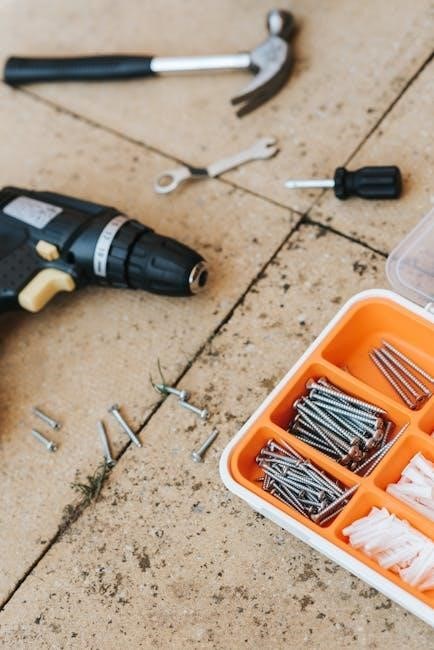Mojave 70 EG is a dispersible granule herbicide containing imazapyr and diuron, mixed with water and surfactants for non-crop areas like highways and railroads, ensuring effective weed control under paved surfaces for long-term management.
1.1 Overview of Mojave 70 EG
Mojave 70 EG is a dispersible granule herbicide designed for non-crop areas like railroads, highways, and utility rights-of-way. It effectively controls weeds by targeting them from shoots to roots, ensuring long-term management. Available in 5 lb. and 25 lb. packages, it replaces Sahara, offering a reliable solution for weed control under paved surfaces when mixed with water and surfactants.
1.2 Importance of Proper Mixing Instructions
Proper mixing of Mojave 70 EG is crucial for effective weed control and environmental safety. Incorrect mixing can lead to reduced efficacy, potential clogging of spray equipment, or unintended environmental impact. Following instructions ensures the herbicide is evenly distributed, maximizing its performance while minimizing risks to non-target areas and ensuring safe application.
Active Ingredients and Mode of Action
Mojave 70 EG contains imazapyr and diuron, targeting weeds by inhibiting growth from shoots to roots and disrupting photosynthesis, ensuring comprehensive weed control through dual action.
2.1 Imazapyr: Targeting Weeds from Shoots to Roots
Imazapyr is a key active ingredient in Mojave 70 EG, targeting weeds systemically from shoots to roots. It inhibits growth by disrupting cellular processes and preventing nutrient uptake. Absorbed quickly, it moves through the plant, ensuring comprehensive control. Imazapyr also prevents seed production, stopping weed regeneration. Its soil activity extends control to germinating seeds, making it highly effective against a broad spectrum of annual and perennial weeds.
2.2 Diuron: Inhibiting Photosynthesis for Effective Weed Control
Diuron, another key ingredient in Mojave 70 EG, inhibits photosynthesis by blocking the conversion of light energy into chemical energy in weeds. This disruption halts cellular processes, leading to cell death. Diuron works synergistically with imazapyr, enhancing overall herbicidal activity. Its rapid action ensures quick results, making it effective for controlling a wide range of weed species when mixed and applied according to instructions.
Safety Precautions and Personal Protective Equipment
Always wear recommended PPE, including gloves, goggles, and a face mask, when handling Mojave 70 EG. Ensure proper ventilation and avoid skin contact to prevent exposure risks.
3.1 Necessary Safety Measures Before Mixing
Before mixing Mojave 70 EG, ensure all protective equipment is worn, including gloves, goggles, and a face mask. Avoid skin contact and eye exposure, as the herbicide can cause irritation. Ensure the mixing area is well-ventilated to prevent inhalation of dust or fumes. Check equipment for damage to prevent leaks or spills. Keep the area clear of unauthorized personnel and pets to minimize exposure risks. Always follow the label instructions carefully.
3.2 Recommended PPE for Handling Mojave 70 EG
When handling Mojave 70 EG, wear long-sleeved shirts, long pants, and closed-toe shoes to minimize skin exposure. Use chemical-resistant gloves to prevent absorption through the skin. Goggles or safety glasses are essential to protect eyes from splashes. A face mask or respirator is recommended to avoid inhaling dust during mixing. Ensure all PPE is in good condition and follows the manufacturer’s guidelines for chemical resistance. Always follow label instructions for additional safety requirements.

Mixing Instructions for Mojave 70 EG

Mix Mojave 70 EG with water and surfactants in a well-ventilated area. Fill the tank with water, add the recommended amount of herbicide, and mix thoroughly for optimal solution preparation.
4.1 Step-by-Step Guide to Preparing the Solution
- FILL the tank with water to about half its capacity.
- ADD the recommended amount of Mojave 70 EG while stirring to ensure even distribution.
- MIX thoroughly until the granules are fully dissolved.
- ADD surfactants as directed to enhance efficacy.
- FILL the tank to the desired level and agitate continuously to maintain the solution’s consistency.
4.2 Importance of Adding Surfactants for Optimal Efficacy
Surfactants are essential for improving the spreading and absorption of Mojave 70 EG on weed surfaces. They reduce surface tension, ensuring better contact between the herbicide and foliage. This enhances penetration and efficacy, leading to more consistent weed control. Always follow the recommended surfactant rates to maximize results and minimize the need for retreatment.
Application Methods and Recommendations
Mojave 70 EG is applied via spray equipment to non-crop areas like highways and railroads. It is effective for weed control under paved surfaces, ensuring long-term management.

5.1 Suitable Surfaces and Areas for Application
Mojave 70 EG is designed for non-crop areas such as highways, railroads, and utility rights-of-way. It is particularly effective on hard surfaces and under paved areas, making it ideal for long-term weed control in these environments. Proper application ensures optimal results in targeted zones.
5.2 Timing and Frequency for Best Results
Apply Mojave 70 EG during the active growing season for optimal weed control. Timing is crucial, targeting weeds during early growth stages enhances effectiveness. Frequency may vary; typically, one application suffices for long-term control, but areas with high weed pressure might require a follow-up treatment. Ensure proper application to minimize reapplication needs, especially after rain or irrigation.
Environmental Considerations
Prevent contamination of water sources by avoiding spray drift and runoff. Protect non-target vegetation and wildlife by following application guidelines to minimize environmental impact.
6.1 Avoiding Contamination of Water Sources
To prevent water contamination, avoid spraying near water bodies and ensure proper application techniques. Use buffer zones around water sources and avoid applying during heavy rain to prevent runoff. Always follow label instructions for safe use.
Additionally, store and dispose of the herbicide and its containers according to guidelines to prevent accidental contamination of water supplies and ecosystems.
6.2 Impact on Non-Target Vegetation and Wildlife
Mojave 70 EG’s active ingredients, imazapyr and diuron, can drift onto non-target vegetation, causing unintended harm. Wildlife may be affected if they ingest treated plants or contaminated water. Proper application techniques and buffer zones are crucial to minimize these risks and protect ecosystems.

Storage and Disposal Guidelines
Store Mojave 70 EG in a cool, dry place away from direct sunlight and moisture. Dispose of unused product and containers according to local regulations, ensuring environmental safety.
7.1 Proper Storage Conditions for Mojave 70 EG
Store Mojave 70 EG in a cool, dry, well-ventilated area away from direct sunlight and moisture. Keep the product in its original container, tightly sealed, and protect it from extreme temperatures. Ensure the storage area is inaccessible to children, pets, and other unauthorized individuals. Avoid storing near incompatible materials or chemicals to prevent contamination or reactions. Maintain a consistent temperature between 40°F and 90°F for optimal product stability.
7.2 Safe Disposal of Unused Product and Containers
Dispose of unused Mojave 70 EG and its containers according to federal, state, and local regulations. Do not pour the product down drains or waterways. Consult with environmental authorities for proper disposal methods. Wear recommended PPE during disposal to minimize exposure. Ensure containers are thoroughly rinsed and decontaminated before recycling or disposal. Follow all applicable hazardous waste guidelines to protect the environment and public health.

Troubleshooting Common Mixing Issues
Address mixing issues by ensuring proper water quantity and surfactant addition. Avoid clumping by stirring thoroughly. Adjust ratios as needed for consistent herbicide suspension and optimal effectiveness.
8.1 Addressing Inconsistent Mixing or Clumping
Inconsistent mixing or clumping in Mojave 70 EG can occur due to improper water volumes or insufficient stirring. Ensure the granules fully dissolve in water before adding surfactants. Agitate thoroughly to prevent clumps, and avoid excessive mixing speeds. If clumping persists, adjust water temperature or wait for granules to wet evenly before stirring. Proper agitation ensures uniform suspension for effective herbicide application.
8.2 Solving Issues Related to Insufficient Efficacy
Insufficient efficacy with Mojave 70 EG may result from incorrect mixing ratios or improper water quality. Ensure the recommended dosage and water volume are accurate, and adjust for water hardness if necessary. Adding the correct amount of surfactant is crucial for optimal herbicide performance. Avoid applying under extreme weather conditions or to stressed vegetation. Proper calibration of equipment and timing of application can also enhance results and ensure effective weed control.
Always follow Mojave 70 EG guidelines for effective weed control. Proper mixing, application timing, and safety measures are key to achieving desired results and ensuring long-term efficacy.

9.1 Summary of Key Mixing and Application Practices
For optimal results, mix Mojave 70 EG with water and surfactants following the recommended ratios. Apply uniformly to target areas, ensuring thorough coverage. Avoid spraying during strong winds or extreme weather conditions to prevent drift and ensure efficacy. Always adhere to safety guidelines and environmental precautions to maximize effectiveness while minimizing risks.
9.2 Best Practices for Long-Term Weed Management
For sustainable weed control, apply Mojave 70 EG consistently, monitor treated areas, and reapply as needed. Implement cultural practices like soil health improvement and competitive planting to prevent weed regrowth. Rotate control methods to avoid resistance and protect non-target vegetation. Regularly inspect and maintain treated zones to ensure long-term efficacy and environmental safety.




























































